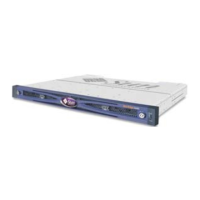5-6 Sun StorEdge 3000 Family Installation, Operation, and Service Manual • May 2004
5.2.2 In-Band Connection
With in-band host connections, you can use Sun StorEdge Configuration Service
software or the command-line interface (CLI). Refer to the:
■ Sun StorEdge 3000 Family Configuration Service User’s Guide for the in-band setup
procedures
■ Sun StorEdge 3000 Family CLI User’s Guide
■ Sun StorEdge 3000 Family Software Installation Guide. This manual provides
installation instructions for all host-based software.
5.3 Summary of Array Configuration
Sun StorEdge 3510 and 3511 FC arrays are preconfigured as follows:
■ Sun StorEdge 3510 FC Array. One or two RAID 5 logical drives with one or two
global spare drives. The array can be used as is or reconfigured.
■ Sun StorEdge 3511 FC Array. One or two NRAID logical drives with no global
spares. The array must be reconfigured.
All configuration procedures can be performed by using the COM port. You can
perform all procedures except the assignment of an IP address through an Ethernet
port connection to a management console.
The typical sequence of steps for completing a first-time configuration of the array is
to:
1. Mount the array on a rack, cabinet, desk, or table.
2. Set up the serial port connection. See “Configuring a COM Port to Connect to a
RAID Array” on page 4-19.
3. Set up an IP address for the controller. See “Setting an IP Address” on page 4-19.
4. Check available physical drives. See “Checking Available Physical Drives” on
page 6-4.
5. Determine whether sequential or random optimization is more appropriate for
your applications and configure your array accordingly. See “Selecting Sequential
or Random Optimization” on page 6-11.
Caution – If you assign an IP address to an Use only the sequential cache
optimization mode with the Sun StorEdge 3511 FC Array.

